The Life Story of Thich Nhat Hanh | Plum Village
Mục Lục
Thich Nhat Hanh’s life in photos
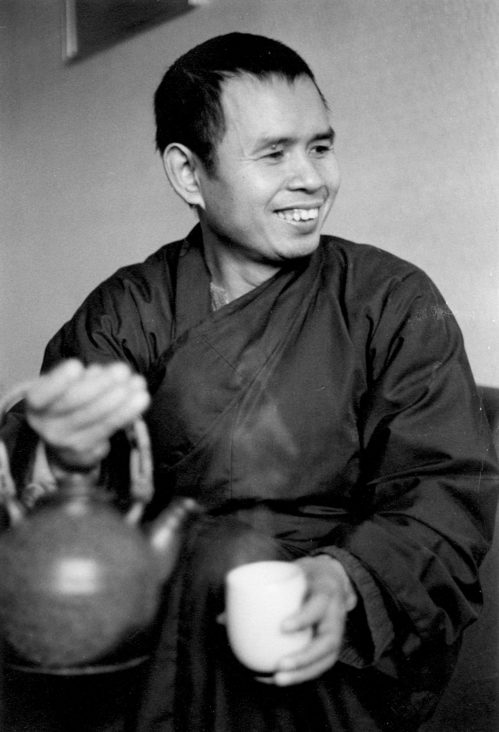
-
Thich Nhat Hanh aged 16 in Huế, Vietnam
Photo taken around 1942, soon after he received novice ordination to enter the monkhood.
© Plum Village Community of Engaged Buddhism (PVCEB). Available in: 1MB+
For a high-res version, and to request permission to use this photo for commercial or non-commercial use, please email: [email protected].
-
Aged 25, shortly after receiving the Bhikshu precepts in 1951.
© Plum Village Community of Engaged Buddhism (PVCEB). Available in: 1MB+
For a high-res version, and to request permission to use this photo for commercial or non-commercial use, please email: [email protected].
-
Thich Nhat Hanh as a young Dharma Teacher (back row, right) with his students, 1950s.
He taught at the new Ấn Quang Buddhist Institute in Saigon.
© Plum Village Community of Engaged Buddhism (PVCEB). Available in: 100KB
For a high-res version, and to request permission to use this photo for commercial or non-commercial use, please email: [email protected].
-
Teaching children to read and write using a song about the Bodhisattva of Great Compassion, early 1960s.
Together with his friends and colleagues, Thich Nhat Hanh developed a social work program for rural development and founded the School of Youth for Social Service.
© Plum Village Community of Engaged Buddhism (PVCEB). Available in: 1MB+
For a high-res version, and to request permission to use this photo for commercial or non-commercial use, please email: [email protected].
-
In 1966, as a young leader in the growing Buddhist peace movement.
He had recently founded Van Hanh University, La Boi Press, the School of Youth for Social Service, and the new Order of Interbeing (based on the traditional bodhisattva precepts). At this time, he was Editor-in-Chief of the leading Buddhist magazine, publishing over 50,000 copies every week.
© Plum Village Community of Engaged Buddhism (PVCEB). Available in: 3MB
For a high-res version, and to request permission to use this photo for commercial or non-commercial use, please email: [email protected].
-
Thich Nhat Hanh travelled to the US to call for peace in 1966.
Original ID: TimeLife_image_116934239
© Time Inc. Photographer: Bill Eppridge for Life Magazine.. Available in: 550KB
For a high-res version, and to request permission to use this photo for commercial or non-commercial use, please email: [email protected].
-
With Dr. Martin Luther King, Jr., at a joint press conference about the war in Vietnam in Chicago, 31 May 1966.
Unknown.
-
Speaking out for peace c.1966
© Plum Village Community of Engaged Buddhism (PVCEB). Available in: 4MB
For a high-res version, and to request permission to use this photo for commercial or non-commercial use, please email: [email protected].
-
Vietnamese refugees aboard the Roland, a ship chartered by Thich Nhat Hanh and his colleagues to rescue people from the seas off Singapore in 1976.
© Plum Village Community of Engaged Buddhism (PVCEB). Available in: 300KB
For a high-res version, and to request permission to use this photo for commercial or non-commercial use, please email: [email protected].
-
Thich Nhat Hanh in Paris in the 1970s.
Exiled for daring to go abroad to call for peace in 1966, he led the Buddhist Peace Delegation at the Paris Peace Talks.
© Jim Forest .
For a high-res version, and to request permission to use this photo for commercial or non-commercial use, please email: [email protected]
-
Gardening at Les Patates Douces (“Sweet Potatoes”) near Paris in the 1970s.
Thich Nhat Hanh and his colleagues and students retreated to the small farmstead in 1975. After the Paris Peace Talks ended with the Paris Peace Accords, Thich Nhat Hanh was denied the chance to return to Vietnam.
-
Thich Nhat Hanh (right) at a Peace March in New York City, 17 June 1982.
Unknown.
-
In south-west France, early 1980s.
Thich Nhat Hanh and his students found land in south-west France, where they established Plum Village mindfulness practice center in 1982.
© Plum Village Community of Engaged Buddhism (PVCEB). Available in: 500KB
For a high-res version, and to request permission to use this photo for commercial or non-commercial use, please email: [email protected].
-
Relaxing with his community in Plum Village, south-west France (late 1980s or early 1990s).
© Plum Village Community of Engaged Buddhism (PVCEB). Available in: 2MB
For a high-res version, and to request permission to use this photo for commercial or non-commercial use, please email: [email protected].
-
Meditation Hall in Plum Village, France, 1990.
Thich Nhat Hanh created meditation halls in the old farm buildings, and began to teach the first generation of meditation practitioners in the West.
© Simon Chaput. Available in: 1MB+
For a high-res version, and to request permission to use this photo for commercial or non-commercial use, please contact: https://www.simonchaput.com/contact
-
Presiding over a “lamp transmission” ceremony to ordain Dharma Teachers, in Plum Village, 1990.
Thich Nhat Hanh began to ordain his first monastic disciples only in 1988, after 35 years of teaching.
© Simon Chaput. Available in: 1MB+
For a high-res version, and to request permission to use this photo for commercial or non-commercial use, please contact: https://www.simonchaput.com/contact
-
In Plum Village, c.2004
© Plum Village Community of Engaged Buddhism (PVCEB). Available in: 600KB
For a high-res version, and to request permission to use this photo for commercial or non-commercial use, please email: [email protected].
-
At Từ Hiếu Temple in Huế, Vietnam, 2005.
In 2005 Thich Nhat Hanh was finally allowed to return to Vietnam after 39 years of exile. Here he is entering the gate at his “root temple” for the first time since he left in May 1966.
© Paul Davis / Touching Peace Photography. Available in: 1MB+
For a high-res version, and to request permission to use this photo for commercial or non-commercial use, please contact: http://www.touching-peace-photography.com/about-1
-
Leading a traditional almsround procession in Huế, Vietnam in 2005.
© Plum Village Community of Engaged Buddhism (PVCEB). Available in: 1MB+
For a high-res version, and to request permission to use this photo for commercial or non-commercial use, please email: [email protected].
-
Planting a bodhi tree in India, 2008.
© Plum Village Community of Engaged Buddhism (PVCEB). Available in: 9MB
For a high-res version, and to request permission to use this photo for commercial or non-commercial use, please email: [email protected].
-
Vulture Peak, India, 2008.
Transmitting the precepts in the open air on Vulture Peak, one of the Buddha’s sacred sites.
© Börje Tobiasson. Available in: 6MB
For a high-res version, and to request permission to use this photo for commercial or non-commercial use, please email: [email protected].
-
Leading a walking meditation, c.2009
© Plum Village Community of Engaged Buddhism (PVCEB). Available in: 800KB
For a high-res version, and to request permission to use this photo for commercial or non-commercial use, please email: [email protected].
-
Thich Nhat Hanh inviting the bell to sound, Plum Village, 2009.
© Plum Village Community of Engaged Buddhism (PVCEB). Available in: 600KB
For a high-res version, and to request permission to use this photo for commercial or non-commercial use, please email: [email protected].
-
Thich Nhat Hanh arriving in Indonesia, 2010.
© Ekayana / Plum Village Community of Engaged Buddhism (PVCEB). Available in: 20MB
For a high-res version, and to request permission to use this photo for commercial or non-commercial use, please email: [email protected].
-
Malaysia, September 2010.
©️ Plum Village Community of Engaged Buddhism (PVCEB). Available in: 10MB
For a high-res version, and to request permission to use this photo for commercial or non-commercial use, please email: [email protected].
-
Thich Nhat Hanh’s European Institute for Applied Buddhism in Waldbröl, Germany, opened in 2008.
©️ Plum Village Community of Engaged Buddhism (PVCEB). Available in: 600KB
For a high-res version, and to request permission to use this photo for commercial or non-commercial use, please email: [email protected].
-
Thich Nhat Hanh reviewing one of his newly-published books in 2011.
He has written over 100 books of poetry, fiction, sutra translations, Engaged Buddhism practices and meditation handbooks.
©️ Plum Village Community of Engaged Buddhism (PVCEB). Available in: 2MB
For a high-res version, and to request permission to use this photo for commercial or non-commercial use, please email: [email protected].
-
Formal lunch with his growing community of monks, 2011
© Plum Village Community of Engaged Buddhism (PVCEB). Available in: 5MB
For a high-res version, and to request permission to use this photo for commercial or non-commercial use, please email: [email protected].
-
Trafalgar Square, London. March 31, 2012.
Thich Nhat Hanh led sitting meditation for over 3,000 people in the heart of the British capital.
Nathanaël Corre. Available in: 1MB+
For a high-res version, and to request permission to use this photo for commercial or non-commercial use, please email: [email protected]
-
Hong Kong Coliseum, 2013
Thich Nhat Hanh addressed an audience of over 10,000.
© Kelvin Cheuk for PVCEB (Plum Village Community of Engaged Buddhists). Available in: 12MB
For a high-res version, and to request permission to use this photo for commercial or non-commercial use, please email: [email protected].
-
Chant of compassion, Hong Kong 2013.
Thich Nhat Hanh’s community invoke the name of the Avalokiteshvara, the Bodhisattva of Great Compassion.
© Martin Lam for Plum Village Community of Engaged Buddhism (PVCEB). Available in: 2MB
For a high-res version, and to request permission to use this photo for commercial or non-commercial use, please email: [email protected].
-
Thich Nhat Hanh listening to his students in Hong Kong, 2013.
-
Broadway, New York City, 2013.
At an exhibition of his calligraphies at ABC Home.
ABC Home / Plum Village Community of Engaged Buddhism (PVCEB). Available in: 730KB
-
With Jim Kim, President of the World Bank, Washington D.C., September 2013.
© Plum Village Community of Engaged Buddhism (PVCEB). Available in: 10MB
For a high-res version, and to request permission to use this photo for commercial or non-commercial use, please email: [email protected].
-
Thich Nhat Hanh teaching children in Plum Village, Summer 2014.
© Plum Village Community of Engaged Buddhism (PVCEB). Available in: 1MB+
For a high-res version, and to request permission to use this photo for commercial or non-commercial use, please email: [email protected].
-
Receiving an honorary doctorate from Hong Kong University, May 2014.
In 2012 Thich Nhat Hanh created a training program for teachers, to bring secular “applied ethics” into the classroom.
©️ Plum Village Community of Engaged Buddhism (PVCEB). Available in: 400MB
For a high-res version, and to request permission to use this photo for commercial or non-commercial use, please email: [email protected].
-
Teaching during a mindfulness retreat for several hundred people in 2014.
Thich Nhat Hanh’s message focusses on how to nourish joy and happiness, and how to handle pain and sorrow.
© Plum Village Community of Engaged Buddhism (PVCEB). Available in: 200KB
For a high-res version, and to request permission to use this photo for commercial or non-commercial use, please email: [email protected].
-
Leading walking meditation with his community in Plum Village, June 2014.
© Plum Village Community of Engaged Buddhism (PVCEB). Available in: 3MB
For a high-res version, and to request permission to use this photo for commercial or non-commercial use, please email: [email protected].
-
Celebrating his 92nd birthday in Thailand, October 2018.
Following a major stroke in November 2014, Thich Nhat Hanh moved to Thailand to join his young disciples from Vietnam at his new Thai Plum Village meditation center.
© Plum Village Community of Engaged Buddhism (PVCEB). Available in: 1MB+
For a high-res version, and to request permission to use this photo for commercial or non-commercial use, please email: [email protected].
-
Returning to Từ Hiếu Temple in Huế, Vietnam, 28 October 2018.
He decided to return to his root temple to spend his remaining days.
Tuoi Tre Magazine, Vietnam.
Zen Master Thich Nhat Hanh is a global spiritual leader, poet, and peace activist, renowned for his powerful teachings and bestselling writings on mindfulness and peace. A gentle, humble monk, Dr. Martin Luther King, Jr. called him “an Apostle of peace and nonviolence” when nominating him for the Nobel Peace Prize. Exiled from his native Vietnam for almost four decades, Thich Nhat Hanh has been a pioneer bringing Buddhism and mindfulness to the West, and establishing an engaged Buddhist community for the 21st Century.
How to pronounce Thich Nhat Hanh
The English pronunciation is: Tik · N’yat · Hawn. However, since Vietnamese is a tonal language, this is only a close approximation of how one would pronounce it in Vietnamese. By his students he is affectionately known as Thay (pronounced “Tay” or “Tie”), which is Vietnamese for “teacher.”
Early Years
Born in central Vietnam in 1926, Thich Nhat Hanh entered Tu Hieu Temple, in Hue city, as a novice monk at the age of sixteen. As a young bhikshu (monk) in the early 1950s he was actively engaged in the movement to renew Vietnamese Buddhism. He was one of the first bhikshus to study a secular subject at university in Saigon, and one of the first six monks to ride a bicycle.
Social activism during war in Vietnam
When war came to Vietnam, monks and nuns were confronted with the question of whether to adhere to the contemplative life and stay meditating in the monasteries, or to help those around them suffering under the bombings and turmoil of war. Thich Nhat Hanh was one of those who chose to do both, and in doing so founded the Engaged Buddhism movement, coining the term in his book Vietnam: Lotus in a Sea of Fire. His life has since been dedicated to the work of inner transformation for the benefit of individuals and society.
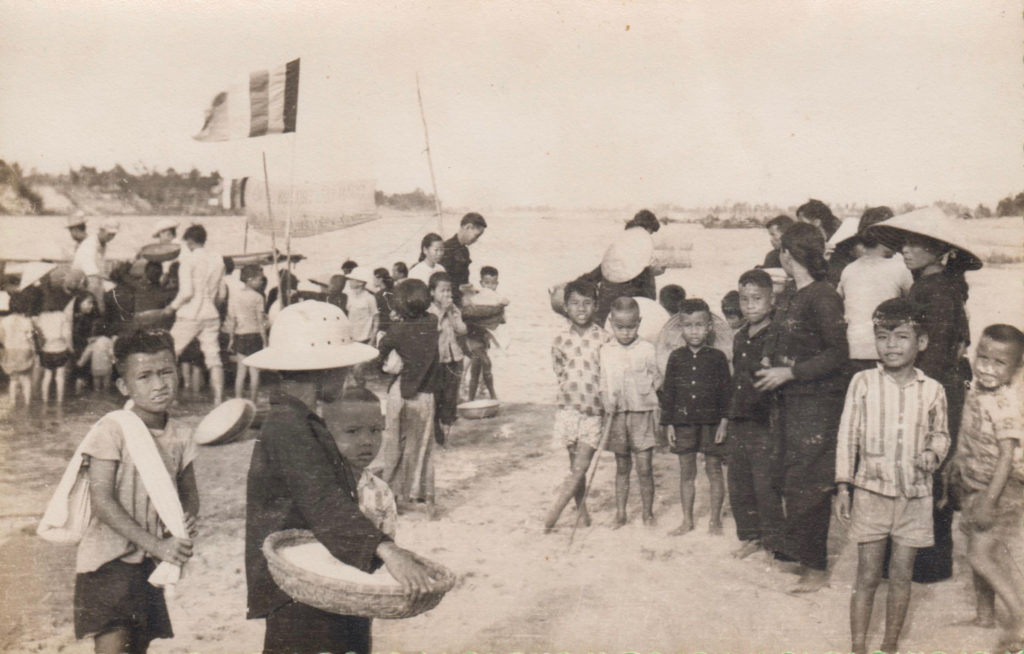
In 1961, Thich Nhat Hanh travelled to the United States on a scholarship to study Comparative Religion at Princeton Theological Seminary and the following year went on to teach and research Buddhism at Columbia University. In Vietnam in the early 1960s, Thich Nhat Hanh founded the School of Youth and Social Service, a grassroots relief organization of 10,000 volunteers based on the Buddhist principles of non-violence and compassionate action.
Meditation is not to escape from society, but to come back to ourselves and see what is going on. Once there is seeing, there must be acting. With mindfulness we know what to do and what not to do to help.
Thich Nhat Hanh
As a scholar, teacher, and engaged activist in the 1960s, Thich Nhat Hanh also founded the Van Hanh Buddhist University in Saigon, La Boi publishing House, and an influential peace activist magazine. In 1966 he established the Order of Interbeing, a new order based on the traditional Buddhist Bodhisattva precepts.
On May 1st, 1966 at Tu Hieu Temple, Thich Nhat Hanh received the ‘lamp transmission’ from Master Chan That.
Exile from Vietnam
A few months later he traveled once more to the U.S. and Europe to make the case for peace and to call for an end to hostilities in Vietnam. It was during this 1966 trip that he first met Dr. Martin Luther King, Jr., who nominated him for the Nobel Peace Prize in 1967. As a result of this mission both North and South Vietnam denied him the right to return to Vietnam, and he began a long exile of 39 years.
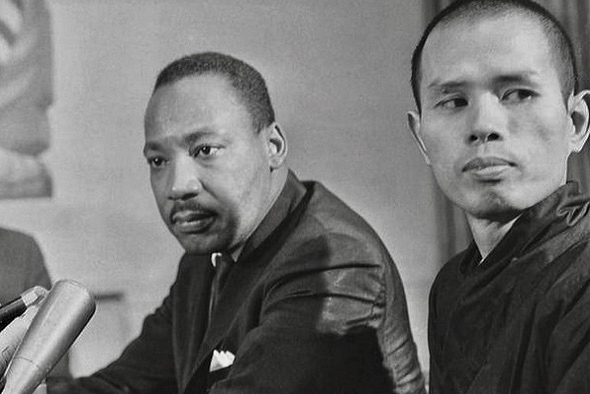 “He is an Apostle of Peace and Nonviolence.” Martin Luther King Jr.
“He is an Apostle of Peace and Nonviolence.” Martin Luther King Jr.
Thich Nhat Hanh continued to travel widely, spreading the message of peace and brotherhood, lobbying Western leaders to end the Vietnam War, and leading the Buddhist delegation to the Paris Peace Talks in 1969.
Founding Plum Village in France
He also continued to teach, lecture and write on the art of mindfulness and ‘living peace,’ and in the early 1970s was a lecturer and researcher in Buddhism at the University of Sorbonne, Paris. In 1975 he established the Sweet Potato community near Paris, and in 1982, moved to a much larger site in the south west of France, soon to be known as “Plum Village.”
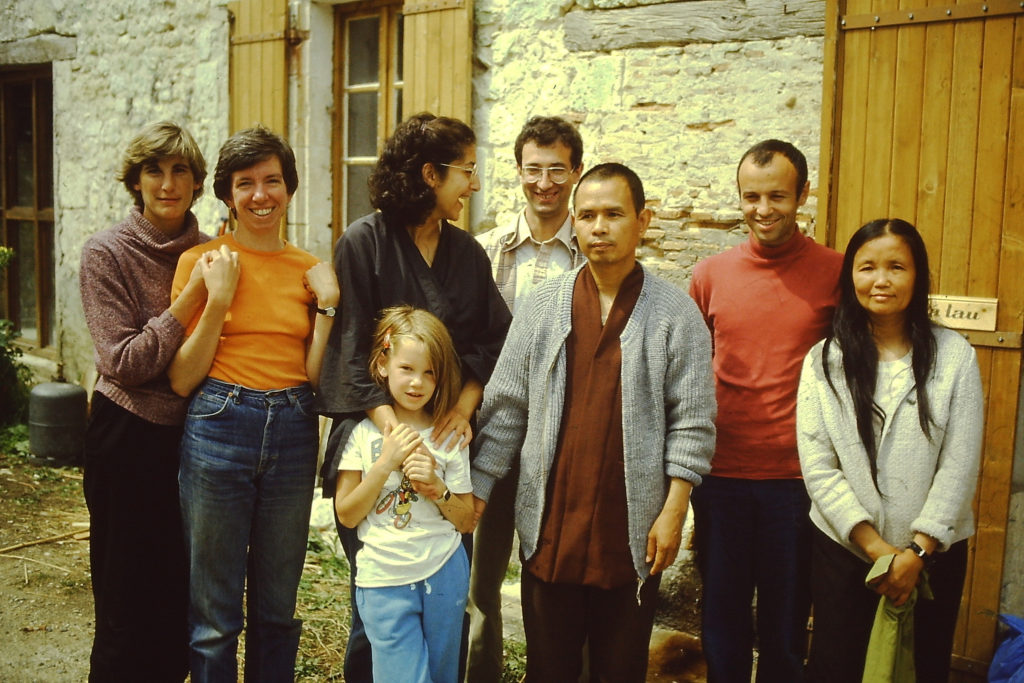 The early days of Plum Village PHOTO: Jim Forest
The early days of Plum Village PHOTO: Jim Forest
Under Thich Nhat Hanh’s spiritual leadership Plum Village has grown from a small rural farmstead to what is now the West’s largest and most active Buddhist monastery, with over 200 resident monastics and over 10,000 visitors every year, who come from around the world to learn “the art of mindful living.”
Plum Village welcomes people of all ages, backgrounds and faiths at retreats where they can learn practices such as walking meditation, sitting meditation, eating meditation, total relaxation, working meditation and stopping, smiling, and breathing mindfully. These are all ancient Buddhist practices, the essence of which Thich Nhat Hanh has distilled and developed to be easily and powerfully applied to the challenges and difficulties of our times.
In the last twenty years over 100,000 people have made a commitment to follow Thich Nhat Hanh’s modernized code of universal global ethics in their daily life, known as “The Five Mindfulness Trainings.”
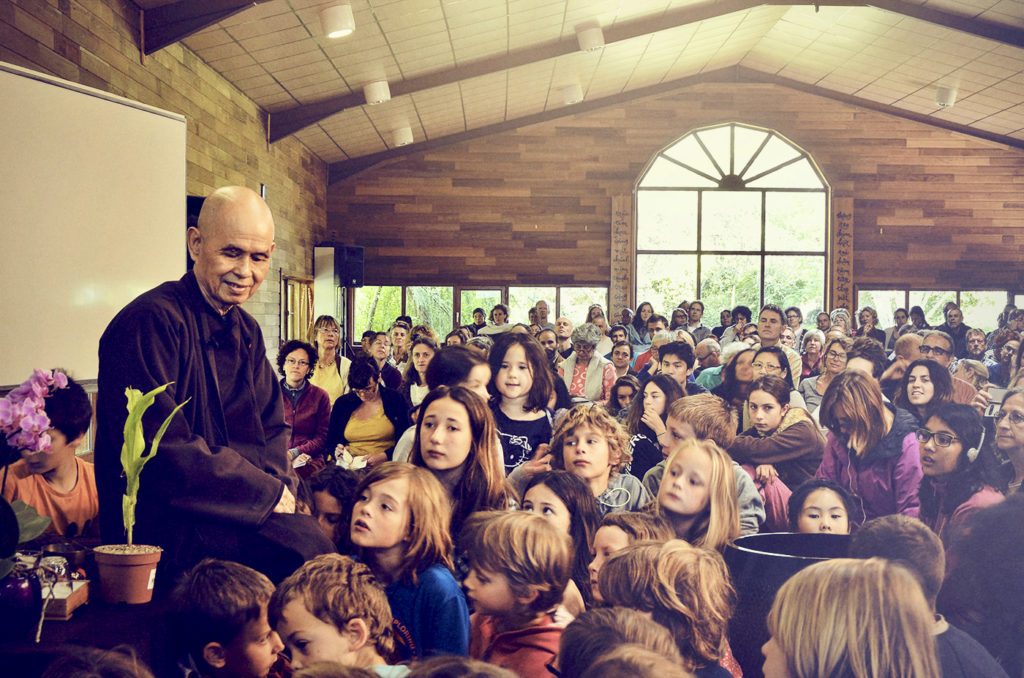 A talk for children in the Still Water Meditation Hall in Upper Hamlet, Plum Village
A talk for children in the Still Water Meditation Hall in Upper Hamlet, Plum Village
More recently, Thich Nhat Hanh has founded Wake Up, a worldwide movement of thousands of young people training in these practices of mindful living, and he has launched an international Wake Up Schools program training teachers to teach mindfulness in schools in Europe, America and Asia.
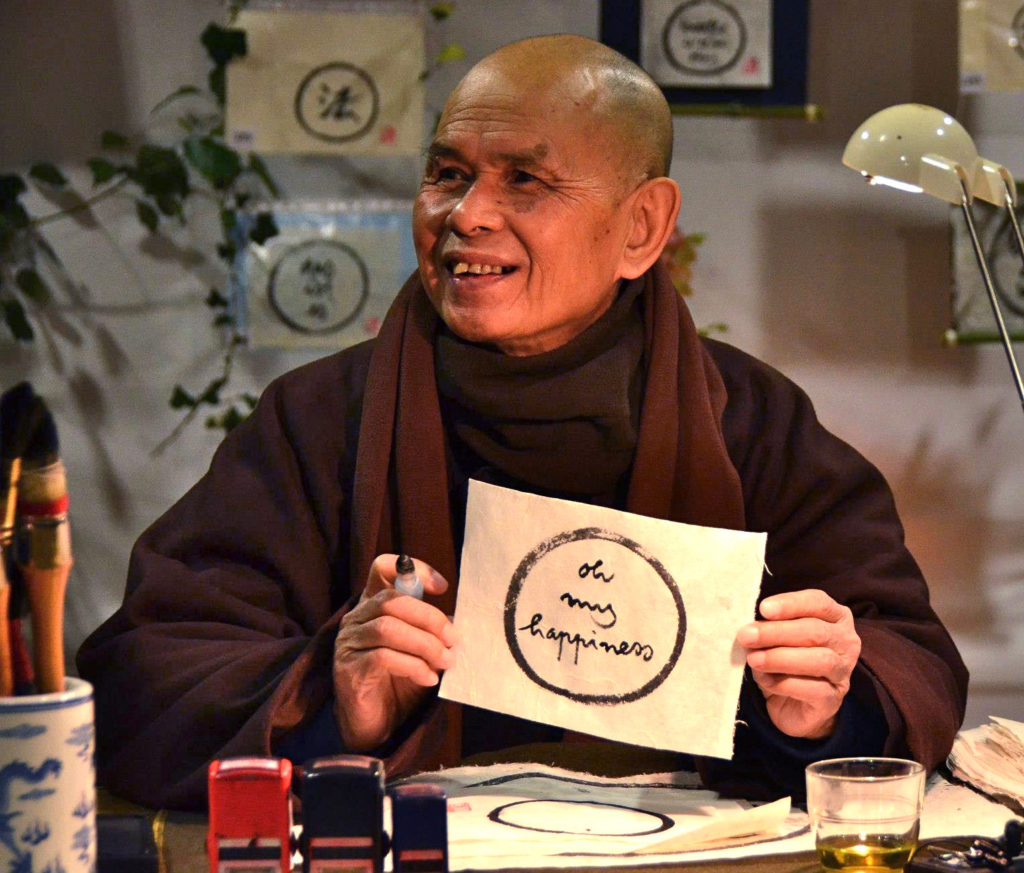 Creating calligraphies, 2013
Creating calligraphies, 2013
Thich Nhat Hanh is also an artist, and his unique and popular works of calligraphy – short phrases and words capturing the essence of his mindfulness teachings – have since 2010 been exhibited in Hong Kong, Taiwan, Canada, Germany, France, and New York.
In the last decade Thich Nhat Hanh has opened monasteries in California, New York, Vietnam, Paris, Hong Kong, Thailand, Mississippi and Australia, and Europe’s first “Institute of Applied Buddhism” in Germany.
Mindfulness Practice Centers in the Plum Village tradition offer special retreats for businesspeople, teachers, families, healthcare professionals, psychotherapists, politicians, and young people as well as war veterans and Israelis and Palestinians. It is estimated that over 75,000 people participate in activities led by Plum Village monks and nuns worldwide every year.
 At the World Bank, September 2013
At the World Bank, September 2013
In recent years Thich Nhat Hanh led events for members of US Congress and for parliamentarians in the UK, Ireland, India, and Thailand. He has addressed the World Parliament of Religions in Melbourne and UNESCO in Paris, calling for specific steps to reverse the cycle of violence, war and global warming. On his visit to the US in 2013 he led high-profile mindfulness events at Google, The World Bank, and the Harvard School of Medicine.
On 11 November 2014, a month after his 88th birthday and following several months of rapidly declining health, Thich Nhat Hanh suffered a severe stroke. Although he was unable to speak, and was mostly paralyzed on the right side, he continued to offer the Dharma and inspiration through his peaceful, serene and valiant presence.
In November 2018, Thich Nhat Hanh moved to Từ Hiếu Temple in Vietnam where he ordained with his teacher when he was sixteen years old. He expressed a wish to stay there for his remaining days. He came out regularly in his wheelchair to visit the temple altars and to lead the sangha on walking meditation around the ponds and ancestral stupas. Thay’s return to Từ Hiếu was a bell of mindfulness reminding us all of how precious it is to belong to a spiritual lineage with deep roots. Whether we have attended a retreat, or simply read one of Thay’s books or watched a talk, and have been touched by his teachings—we are all connected to this ancestral stream of wisdom and compassion.
Thay passed away peacefully in the early moments of 22 January 2022, in the Deep Listening Hut at Từ Hiếu Temple in Huế, surrounded by loving disciples. Around the world, online and in-person, hundreds of thousands of people in the Plum Village International community collectively observed a week of mindfulness practice and ceremonies, generating a powerful energy of compassion, peace, and brotherhood and sisterhood. Thich Nhat Hanh’s Funeral and Cremation took place on Saturday 29th January in Huế, his ashes distributed among his practice centers in Europe, the US and Asia.
Thich Nhat Hanh’s living legacy of engaged Buddhism is continued by his community of over 700 monastic disciples at 11 monasteries, as well as by hundreds of lay Dharma Teachers, thousands of members of his Order of Interbeing, and hundreds of thousands of followers worldwide. Through online teachings, retreats, teaching tours and engaged actions, the International Plum Village Community of Engaged Buddhism is carrying his extraordinary contribution forward.
To stay in touch with activities of Thay’s community, bringing his teachings and practices into the world, please sign up to The Raft (a twice-monthly newsletter). To lend your energy to help Thay’s legacy continue far into the future, please consider supporting the Thich Nhat Hanh Foundation.
- For a more detailed account of Thich Nhat Hanh’s life, you may like to read his extended biography.






